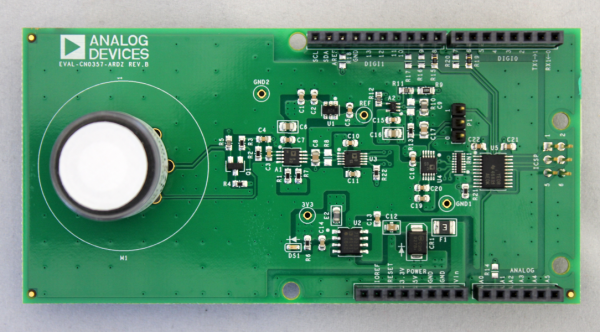 This version (22 Sep 2016 20:53) is a draft.
This version (22 Sep 2016 20:53) is a draft.
This is an old revision of the document!
CN0357 single-supply, low noise, portable gas detector circuit using an electrochemical sensor. The Alphasense CO-AX carbon monoxide sensor is used in this example. Electrochemical sensors offer several advantages for instruments that detect or measure the concentration of many toxic gases. Most sensors are gas specific and have usable resolutions under one part per million (ppm) of gas concentration.
The circuit shown in below uses the ADA4528-2, dual auto zero amplifier, which has a maximum offset voltage of 2.5 µV at room temperature and an industry leading 5.6 µV/√Hz of voltage noise density. In addition, the AD5270-20 programmable rheostat is used rather than a fixed transimpedance resistor, allowing for rapid prototyping of different gas sensor systems, without changing the bill of materials.
The ADR3412 precision, low noise, micropower reference establishes the 1.2 V common-mode, pseudo ground reference voltage with 0.1% accuracy and 8 ppm/°C drift.
For applications where measuring fractions of ppm gas concentration is important, using the ADA4528-2 and the ADR3412 makes the circuit performance suitable for interfacing with a 16-bit ADC, such as the AD7790.

PICTURE OF THE BOARD FILE with JUMPERS AND CONNECTORS HIGHLIGHTED
NOTE - Three electrode electrochemical toxic gas sensors can be used with the EVAL-CN0357-ARDZ The footprint can accommodate 3 different sizes of sensors.
The Alphasense CO-AX electrochemical gas sensor was used during testing and programming.
Recommended PCB Sockets(for Alphasense Sensors)
Jumper P1 Settings
NEED CHIP select picture of header!!!
| AD7790_CS Pins (P??) | Arduino GPIO Pin (P??) |
|---|---|
| Pin 1 shunted to Pin 2 | GPIO 8 |
| Pin 3 shunted to Pin 4 | GPIO 9 |
| Pin 5 shunted to Pin 6 | GPIO 10 |
NEED CHIP select picture of header!!!
| AD5270_CS Pins (P??) | Arduino GPIO Pin (P??) |
|---|---|
| Pin 1 shunted to Pin 2 | GPIO 8 |
| Pin 3 shunted to Pin 4 | GPIO 9 |
| Pin 5 shunted to Pin 6 | GPIO 10 |
EVAL-CN0359-EB1Z Rev B Files
EVAL-CN0359-EB1Z Rev A Files
RevB to RevC:
RevA to RevB: